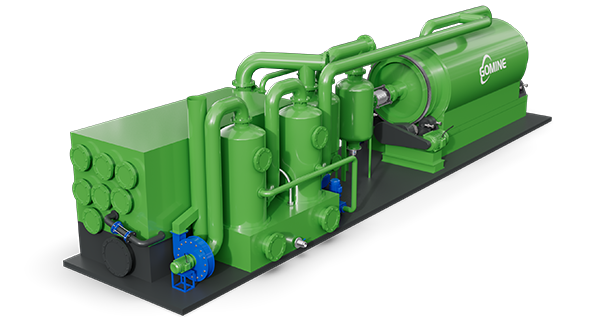The oil sludge pyrolysis treatment equipment adopts a closed low-temperature pyrolysis process to convert oil sludge into reusable resources in an oxygen-free environment. The equipment is suitable for processing various types of oil sludge, including ground oil sludge, refinery oil sludge, and oil sludge at the bottom of storage tanks. Through efficient separation technology, the organic matter in the oil sludge can be converted into fuel oil, combustible gas and dry solid residue to maximize the utilization of resources.

Applicable raw materials
The equipment is suitable for the treatment of various oily wastes, including but not limited to:
- Oilfield drilling mud
- Refinery residue
- Oil sludge at the bottom of the tank
- Oil sludge leaked during transportation
Oil Sludge Pyrolysis Plant Process Flow
- Pretreatment stage
Before pyrolysis, sludge usually needs to be pretreated to remove impurities, adjust water content and improve fluidity. This stage may include:
Dehydration: reduce the water content of sludge by natural sedimentation, centrifugal separation or hot air drying.
Crushing and screening: crush large pieces of sludge into appropriate particle size for subsequent processing.
Conditioning: add additives as needed to improve the physical properties of sludge.
- Water evaporation stage (about 100–140°C)
In this stage, the sludge is heated to 100–140°C, the main purpose of which is to evaporate the water in it. Since the evaporation of water requires the absorption of a large amount of heat, this process is relatively slow, but it creates favorable conditions for the subsequent pyrolysis reaction.
- Pyrolysis reaction stage (about 140–500°C)
When the temperature rises to 140–500°C, the organic matter in the sludge begins to undergo pyrolysis and decomposes into:
Fuel oil: mainly composed of light hydrocarbons, which can be used as industrial fuel or further refined.
Combustible gas: such as methane, hydrogen, etc., can be used to heat the pyrolysis furnace to achieve energy self-sufficiency.
Solid residue: mainly carbon black and inorganic matter, which can be used for building materials or other purposes.
This stage is the core of the entire pyrolysis process. The reaction rate and product distribution are affected by factors such as temperature, heating rate and raw material properties.
- Condensation and separation stage
The oil and gas mixture produced by pyrolysis passes through the condensation system and is separated into liquid fuel oil and non-condensable combustible gas after cooling. The fuel oil is collected and stored, and the non-condensable gas can be used to heat the pyrolysis furnace to form a recycling of energy.
- Tail gas treatment stage
To meet environmental protection requirements, the tail gas needs to undergo multi-stage purification treatment, including:
Dust removal: remove particulate matter to prevent air pollution.
Desulfurization and denitrification: reduce the emission of SO₂ and NOx to meet emission standards.
Activated carbon adsorption: remove organic volatiles to ensure that the tail gas meets emission standards.
Final Products and Applications of Oil Sludge Pyrolysis Plant
Fuel oil (45–55%): can be sold directly to refineries, steel mills, cement plants, etc., or further distilled and refined into diesel.
Dry solid slag (30–35%): can be used for building materials, roadbed fillers, etc., and meets environmental emission standards.
Combustible gas (8–10%): after purification, it can be used as equipment’s own heating fuel to reduce operating costs.
Core Advantages of GOMINE Oil Sludge Pyrolysis Plant
- Continuous intelligent operation
The equipment supports 24-hour continuous feeding and discharging, equipped with a PLC automatic control system to achieve full-process intelligent management, ensuring stable and efficient operation.
- Triple anti-coking technology
Through multiple measures such as hot flue gas circulation, catalyst application and physical friction, it effectively prevents coking in the reactor and extends the service life of the equipment.
- Precise temperature control system
The high-temperature induced draft fan and burner work together to accurately control the reaction temperature, optimize the pyrolysis efficiency, and recover waste heat at the same time, reducing energy consumption by more than 20%.
- Efficient condensation and gas recovery
Integrated three-in-one condensation system, quickly cools oil and gas, and improves fuel oil yield; non-condensable gas can be used as auxiliary fuel after purification to reduce operating costs.
- Environmentally friendly emission
Equipped with a multi-stage exhaust gas purification device to ensure that exhaust gas emissions meet the environmental protection standards of the European Union and the US EPA, truly realizing green production.
Technical Parameters of Oil Sludge Pyrolysis Plant
| Models | Batch Design (GM-BLJ-5) | Semi-Continuous Design (GM-SLJ-15) | Continuous Design (GM-CLJ-20) |
| Unit Capacity | 5~20 Tons/day | 15~25 Tons/day | 20~70 Tons/day |
| Feedstock Size | ≤1600mm | ≤100mm | ≤80mm |
| Feedstock Pretreatment | – | Need to be pre-processed by shredder or grinder to the appropriate size | Need to be pre-processed by shredder or grinder to the appropriate size |
| PLC | Optional | Optional | Equipped with |
| Reactor Cooling Time | 3~12 hours | 3~5 hours | 0 |
| Power | 12~25 kW/h | 15~30 kW/h | 50 kW/h |
| Maintenance Period | 1 day | 7~10 days | 45~60 days |
We are experts in the field of solid waste recycling especially metal recycling. We can provide a complete set of solutions, including waste cable recycling, waste circuit board recycling, metal and non-metal crushing and sorting, mixed plastic recycling, etc. If you have any need of our machine, feel free to contact Gomine Machinery.


